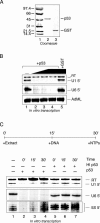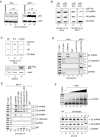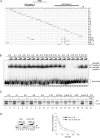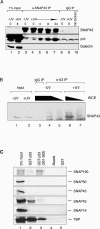The p53 tumor suppressor protein represses human snRNA gene transcription by RNA polymerases II and III independently of sequence-specific DNA binding
- PMID: 15798209
- PMCID: PMC1069601
- DOI: 10.1128/MCB.25.8.3247-3260.2005
The p53 tumor suppressor protein represses human snRNA gene transcription by RNA polymerases II and III independently of sequence-specific DNA binding
Abstract
Human U1 and U6 snRNA genes are transcribed by RNA polymerases II and III, respectively. While the p53 tumor suppressor protein is a general repressor of RNA polymerase III transcription, whether p53 regulates snRNA gene transcription by RNA polymerase II is uncertain. The data presented herein indicate that p53 is an effective repressor of snRNA gene transcription by both polymerases. Both U1 and U6 transcription in vitro is repressed by recombinant p53, and endogenous p53 occupancy at these promoters is stimulated by UV light. In response to UV light, U1 and U6 transcription is strongly repressed. Human U1 genes, but not U6 genes, contain a high-affinity p53 response element located within the core promoter region. Nonetheless, this element is not required for p53 repression and mutant p53 molecules that do not bind DNA can maintain repression, suggesting a reliance on protein interactions for p53 promoter recruitment. Recruitment may be mediated by the general transcription factors TATA-box binding protein and snRNA-activating protein complex, which interact well with p53 and function for both RNA polymerase II and III transcription.
Figures






Similar articles
-
Distinct mechanisms for repression of RNA polymerase III transcription by the retinoblastoma tumor suppressor protein.Mol Cell Biol. 2004 Jul;24(13):5989-99. doi: 10.1128/MCB.24.13.5989-5999.2004. Mol Cell Biol. 2004. PMID: 15199152 Free PMC article.
-
A variety of RNA polymerases II and III-dependent promoter classes is repressed by factors containing the Krüppel-associated/finger preceding box of zinc finger proteins.Gene. 1999 Jul 8;234(2):381-94. doi: 10.1016/s0378-1119(99)00182-1. Gene. 1999. PMID: 10395912
-
Cooperation between small nuclear RNA-activating protein complex (SNAPC) and TATA-box-binding protein antagonizes protein kinase CK2 inhibition of DNA binding by SNAPC.J Biol Chem. 2005 Jul 29;280(30):27697-704. doi: 10.1074/jbc.M503206200. Epub 2005 Jun 14. J Biol Chem. 2005. PMID: 15955816
-
Regulation of snRNA gene expression by the Drosophila melanogaster small nuclear RNA activating protein complex (DmSNAPc).Crit Rev Biochem Mol Biol. 2011 Feb;46(1):11-26. doi: 10.3109/10409238.2010.518136. Epub 2010 Oct 6. Crit Rev Biochem Mol Biol. 2011. PMID: 20925482 Review.
-
Crossing the line between RNA polymerases: transcription of human snRNA genes by RNA polymerases II and III.Cold Spring Harb Symp Quant Biol. 1998;63:111-20. doi: 10.1101/sqb.1998.63.111. Cold Spring Harb Symp Quant Biol. 1998. PMID: 10384275 Review. No abstract available.
Cited by
-
Requirement for SNAPC1 in transcriptional responsiveness to diverse extracellular signals.Mol Cell Biol. 2012 Nov;32(22):4642-50. doi: 10.1128/MCB.00906-12. Epub 2012 Sep 10. Mol Cell Biol. 2012. PMID: 22966203 Free PMC article.
-
Comprehensive molecular biomarker identification in breast cancer brain metastases.J Transl Med. 2017 Dec 29;15(1):269. doi: 10.1186/s12967-017-1370-x. J Transl Med. 2017. PMID: 29287594 Free PMC article.
-
Covalent small ubiquitin-like modifier (SUMO) modification of Maf1 protein controls RNA polymerase III-dependent transcription repression.J Biol Chem. 2013 Jun 28;288(26):19288-95. doi: 10.1074/jbc.M113.473744. Epub 2013 May 14. J Biol Chem. 2013. PMID: 23673667 Free PMC article.
-
One function--multiple mechanisms: the manifold activities of p53 as a transcriptional repressor.J Biomed Biotechnol. 2011;2011:464916. doi: 10.1155/2011/464916. Epub 2011 Mar 8. J Biomed Biotechnol. 2011. PMID: 21436991 Free PMC article. Review.
-
Ferroptosis: An emerging therapeutic opportunity for cancer.Genes Dis. 2020 Sep 29;9(2):334-346. doi: 10.1016/j.gendis.2020.09.005. eCollection 2022 Mar. Genes Dis. 2020. PMID: 35224150 Free PMC article. Review.
References
-
- Barlev, N. A., L. Liu, N. H. Chehab, K. Mansfield, K. G. Harris, T. D. Halazonetis, and S. L. Berger. 2001. Acetylation of p53 activates transcription through recruitment of coactivators/histone acetyltransferases. Mol. Cell 8:1243-1254. - PubMed
-
- Budde, A., and I. Grummt. 1999. p53 represses ribosomal gene transcription. Oncogene 18:1119-1124. - PubMed
-
- Cain, C., S. Miller, J. Ahn, and C. Prives. 2000. The N terminus of p53 regulates its dissociation from DNA. J. Biol. Chem. 275:39944-39953. - PubMed
Publication types
MeSH terms
Substances
Grants and funding
LinkOut - more resources
Full Text Sources
Other Literature Sources
Research Materials
Miscellaneous
